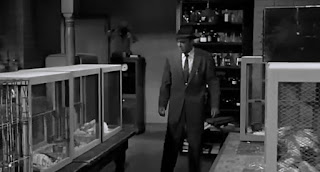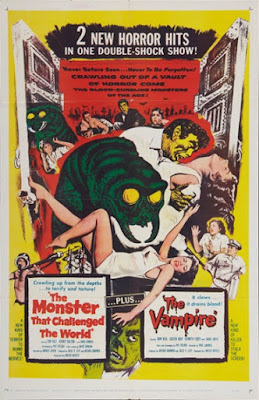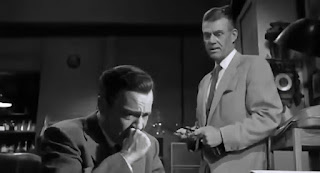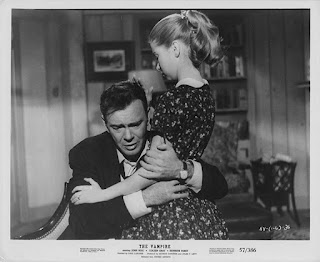After a somewhat calamitous chain of events, a small town doctor mistakenly takes the wrong pills while trying to fight off a persistent migraine. But these weren’t just any pills. You see, it all began earlier that day when young Tommy bursts into the office of Dr. Paul Beecher, saying he needed to come quick to Dr. Campbell’s house. Seems Tommy (Morrow) works as a delivery boy for an animal broker and was delivering another shipment of rats to Campbell’s lab located in the basement of his old Victorian house. But when he got there, Campbell (Romoff ) was slumped over his desk, barely alive, and told the boy to fetch Dr. Beecher as fast as he can.
Apparently, Campbell was a patient of Dr. Beecher (Beal), who had been suffering through the late stages of congestive heart failure. I say ‘was’ and ‘had” because by the time Beecher arrives, Campbell is barely hanging on, raving about how everyone must know what he’s done. He’s found the answer, and the answer to whatever he’s talking about is in a bottle of mystery pills he entrusts to Beecher before expiring.
Later that day, Beecher drops off his report for the coroner to his friend, Buck Donnelly (Tobey). Donnelly is the town sheriff, and while it appears to have just been an inevitable coronary he still has a few questions about what Campbell was up to in that weird lab of his. Here, Beecher tells him everything he knows, which isn’t much: Campbell was sanctioned by the local university, who is sending an old college friend of Beecher’s to take over the experiments. As to what those experiments were exactly, Beecher doesn’t know for sure. Something about primitive instincts, and trying to regress the brain chemically to tap into them.
When he returns to his office, which is located in his home, Beecher isn’t in the best of moods after losing a patient. And on top of that, he feels another migraine coming on. And as he prepares for his next patient, his attentive daughter, Betsy (Reed), fetches his migraine pills out of his coat pocket as asked -- the same coat he stuck Campbell’s mystery pills into. Unaware of that, Betsy removes one of the pills and gives it to her father, who downs it with a glass of water.
Meantime, Beecher’s nurse, Carol Butler (Gray) brings in his last patient of the day: Marion Wilkins (Staunton), who isn’t feeling well and thinks it might be her heart murmur acting up again. Beecher, whose own condition isn’t improving, thinks this might just be all psychological after Marion heard about Campbell’s fatal heart attack. But with his head splitting, he begs to cut the appointment short, promising if she comes back right away in the morning he will run another EKG check on her heart just to be safe. With that, Carol and Betsy help Beecher lie down on the couch in his office, where he hopes to sleep off the damnable headache.
The following morning, Sheriff Donnelly stops by the office and runs into the arriving Carol, who lets him in when no one answers the door. Seems there was a prowler reported in the neighborhood last night and he is canvassing the neighborhood to check if anyone else saw anything. Beecher emerges from his office, having just woken up after an 18-hour power nap. He remembers nothing after lying down but not only does he feel better, he seems strangely invigorated. He then takes a call from Marion Wilkins’ cleaning lady, who says the woman is laid up in bed, is deathly pale, and acts awful sick.
When Beecher arrives, Marion isn’t responsive at first. And as the doctor notes two small puncture wounds on her neck, Marion revives and sees him, which triggers a five alarm freak-out as she shouts for him to stay away and to stop touching her. And as Beecher tries to calm the hysterical woman down, she suddenly collapses as her weakened heart finally gives out. Shocked by the outburst directed at him, Beecher is puzzled even further when he finds a pen he’d been looking for all morning halfway under his patient’s bed.
Now the guilt of losing two patients in two days weighs heavily on the good doctor, especially since he turned Marion away yesterday when she evidently needed his help. This stress triggers another migraine, and as Beecher retrieves his pills he finds two bottles in his coat pocket: his migraine meds and Campbell’s mystery pills. And with his subconscious gnawing at him, and an 18-hour black hole in his memory, Beecher asks his daughter if she accidentally gave him the wrong pill last night.
Assuring her she’s not in trouble and the wrong pills aren’t dangerous, Betsy honestly isn’t sure which bottle she used. But Beecher is pretty sure he took the wrong pill. And unsure of what it does, he returns to Campbell's lab, where he finds all the lab animals dead -- except for the bats.
His old college buddy, Dr. Will Beaumont (Greer), now the head of the university’s psychology department, is also there along with his assistant, Henry Winston (Griffith), who will be taking over the lab for Campbell. And as Winston does a necropsy on one of the rats to find a cause of death, Beecher gets all the information he can on what Campbell was up to, which isn’t much as Beaumont puts the 'fudd' in fuddy old professor.
What he does learn is Campbell was experimenting with certain chemicals, trying to regress the brain to a more primitive state. And once he accomplished that, they hoped to reverse engineer the process to expand the mind and increase intellect. And those pills he created triggered this regressive action. And worse yet, they were narcotically habit forming and if his test subjects didn’t get their daily dose they went wild and became dangerously aggressive. Now, the main purpose of the pill was to reduce blood flow to the brain because … SCIENCE! And now, after not getting their daily dosage, all the test subjects are dead from what Winston describes as a total capillary disintegration.
That evening, Beecher isn’t sure what to do but he ultimately does not take another pill. Later that night, Betsy tries to check on him. He was very upset when he got home and acted way out of character when he scolded her for playing her records too loud. But his door is locked and there is no response. With that, the girl returns to bed. But a quick peek inside shows her father’s bedroom is empty, the bottle of pills is ajar and the contents scattered all over the desk, and the window is open.
Cut to the lab, where Winston is talking with Beaumont over the phone. He’s discovered the pills are most likely a control serum derived from the bats -- and not just any bats, but vampire bats, which are the only things immune to this ravaging blood disease. After he hangs up, a man lunges from the darkness and savagely attacks Wilson. And when his body is found the next morning, his neck will also show the same two puncture wounds...
Initially mustering together in 1943 as part of the First Motion Picture Unit of the U.S. Army Air Corps., Jules Levy, Arthur Gardner and Arnold Laven started kicking around the idea of forming their own motion picture production company once the war was over. It took nearly seven years of collective work as script supervisors, assistant directors, and production managers at other studios before the trio finally made good on that oath with the B-Noir thriller / police procedural Without Warning (1952), where a jilted husband takes out his repressed anger on a succession of lookalikes of his unfaithful wife.
And though the Levy-Gardner-Laven label really left their mark in the 1960s with a series of westerns -- The Scalphunters (1968), Sam Whiskey (1969), and episodic television -- The Riflemen, The Big Valley, before backing John Wayne -- McQ (1974), Brannigan (1975), and Burt Reynolds -- White Lightning (1973), Gator (1976) in the 1970s, after a couple of more crime capers the trio also unleashed a quartet of relatively unsung creature features as the 1950s closed out for their parent company, United Artists.
Pat Fielder, meantime, was a recent graduate of UCLA's theater department, unemployed, and working on hammering out a stage play, who stumbled into an opportunity of a lifetime when she agreed to fill in as a temporary secretary for L-G-L productions -- going by the handle of Gramercy Pictures at the time. Along with typing up the script for Vice Squad (1953), with her theater background, Fielder soon found herself cross-promoted to spec-script reader, story editor, and production assistant when she helped director Laven scout locations and sketch out his set-ups, which officially knocked the temporary tag off her title. Then, after UA gave the OK on what was to become The Monster that Challenged the World (1957), when the original script treatment didn't pass muster, Fielder convinced her triumvirate of bosses to give her a crack at rewriting it; and the rest, as they say, is film history.
When The Monster that Challenged the World was finished, UA was so happy with the results they immediately commissioned L-G-L to make a companion feature for the bottom half of the required double-bill. Needing something quick and cost-effective -- the follow-up would have about half of Monster's budget, after a brain-storming idea-session, it was decided to bring the macabre into the suburbs with The Vampire (1957).
Once more, they turned to Fielder for the script, who laid the foundation for a very terse, tight and well-executed fright flick even though it had everything, including the kitchen sink, thrown into it: mad science, notions of vampirism and lycanthropy -- all narcotically induced like Jekyll and Hyde. There's even a couple of nods to the creeping dread of Val Lewton and Jacques Tourneur, especially when Beecher looks to Carol for some help as he realizes what the pills are doing to him.
And while he wants her to bird-dog him to make sure he stays off the pills circumstances derail this plan when he’s called in to perform an emergency surgery (-- after a night of heavy drinking, I might add), and like with any addict his scheming leads to another dose, leading to quite the delightfully creepy scene where our heroine realizes those footfalls aren't her own echoes as she moves down a dark and deserted street.
And while Carol manages to survive this harrowing encounter, an older woman out walking her dog does not. And as her screams bring help too late, we finally get a good look at the brutish killer.
That makes three deaths in three days, which proves a little too suspicious for both Beecher, who is beginning to suspect he is the killer, and Donnelly, who doesn’t buy into three heart attacks in three days and asks the coroner to dig further. And so, fearing he is losing his mind and unsure of who’ll die during his next blackout, a desperate Beecher arranges to get Betsy out of town and, needing to confess to someone, seeks out Beaumont at the lab.
Meantime, Donnelly is in the process of getting Marion Wilkins’ body exhumed to link it to the other two suspicious deaths, which were caused by total capillary disintegration. The coroner also reveals that the saliva of whatever bit them on the neck transferred a deadly virus, which triggered the devastating blood disease and cardiovascular collapse. But it’s not a what, but a who as several witnesses saw a man fleeing the latest crime scene.
Meanwhile, Beaumont does his best to calm Beecher down as he lays it all out: 3 pills plus 3 days equals 3 deaths. He doesn’t really remember killing Marion, Winston or the old woman, just an impression of it. Ever the psychiatrist, Beaumont believes his friend has fallen under the spell of a suggestive influence when it comes to the blood-extract pills, assuring his friend he’s no ersatz vampire. And before he goes confessing to Donnelly and ruining his life over nothing, Beaumont takes possession of the pills and offers to sit with Beecher all night to prove he is right.
At the cemetery, Donnelly oversees the disinterment of Marion Wilkins. But once they open the casket, they’re all shocked by what they see. And so shocked by the condition of the body, the Sheriff isn’t sure if they’ve got the right grave as the corpse has nearly disintegrated. But it is Marion, confirming she also had the wasting disease. And so, figuring the killer will strike again, Donnelly beefs up patrols, hoping to catch the culprit before he strikes again.
Back at the lab, Beecher’s violent withdrawal symptoms have a worried Beaumont considering the use of a sedative. But it’s already too late as he watches his friend transform and regress into a brutish troglodyte-like humanoid. Like with Dr. Jekyll, it appears the effect of the pills are cumulative and Beecher no longer needs them to regress into this monster, who savagely attacks and kills Beaumont, and then disposes of his body by stuffing it into the incinerator like all the other dead lab animals.
The following morning, as he connects the dots, Donnelly stops by the lab to confront Beaumont, feeling maybe they took things too far in their regressive blood research and started experimenting on humans. Of course, no one is there but he stumbles upon a recording of last night's incident -- the absent-minded Beaumont had been dictating and left the machine running, which not only reveals Beaumont’s death but who killed him: Paul Beecher.
Meantime, Beecher is at his home, getting his affairs in order. Knowing he will most likely keep on killing, the man sees only one way out and plans to kill himself. But Carol arrives and disrupts his suicide attempt. And as he grows more agitated, Beecher feels the change coming on again. He tries to get Carol to leave but she stubbornly refuses, even after getting punched in the face, giving her a front-row seat for his latest transformation.
But Donnelly arrives just in time as he hears Carol screaming and breaks in before she is bitten. And then we sprint toward the climax as Carol runs away and is chased by the monster, who is pursued by Donnelly and his posse. When the monster catches up to Carol, Donnelly is able to drive it off with his pistol. Once Carol is safe, the pursuit continues and it soon comes to blows between Donnelly and the monster.
Overpowered and about to be bitten, Donnelly’s hashed is saved when the other patrolmen catch up and shoot the monster, who collapses. And as it passes away, the vampire-like creature slowly reverts back to Beecher as the others solemnly watch. And I’d hate to be the one who has to break the news to poor Betsy.
Feeling he lost out on a more prestigious directing gig due to his last picture being about killer crustaceans from the Salton Sea, Arnold Laven wanted to disassociate himself from this type of genre picture, and so, Paul Landres took over as director for The Vampire.
Behind the camera, Jack Mackenzie had actually worked with Val Lewton on Isle of the Dead (1945), and together, with Fielder's script, their extremely effective efforts is amplified by a dedicated cast -- always good to see Ken Tobey working, a couple of great shocks (-- the reveal of the desiccated corpse), and a few gruesomely macabre moments (-- the disposal of Beaumont in the incinerator). Then, there's Gerald Fried's score, whose main theme is so effective and is eerily prescient of the violent strings John Williams used so effectively for JAWS (1975).
And the only real complaint I have and the film's only real failure is with the make-up for our monster, which is less horrific and more of a drunken sod who fell face first into a mud puddle.
As a long time fan of The Monster that Challenged the World, I have no idea why it took me so long to catch up with it's co-feature. And The Vampire turned out so damned good -- hell, great, it had me anxious to check out L-G-L's follow up double-feature, The Return of Dracula (1958) -- which was pretty good, and The Flame Barrier (1958), which was not. Fielder pitched in on the scripts for these, too, co-writing the latter with George Worthing Yates -- THEM! (1954), The Amazing Colossal Man (1957). I hate to call it a feminine touch but one can sense something a little different about those features she had a hand in; something a little less perfunctory about the love interests and auxiliary characters; something almost, well, motherly.
And one of the elements I really appreciated in The Vampire was the time spent on the family dynamic subplot between the infected doctor and his daughter, who thinks her widower father's violent mood swings are all her fault, which has less to do with her unknowingly giving him the wrong bottle of pills and more to do with that's just the way a kid's mind works when their parents are falling apart in front of them.
And the doctor's later efforts to keep her at arm's length and eventually get her out of harm's way by pawning her off on a distant relative, when he refuses to explain why, is some pretty heart-wrenching stuff. Definitely some scars left, there. Credit to both John Beal and Lydia Reed for the execution and to Fielder for fleshing these characters out, which eventually makes the penultimate climax and the unseen aftermath of The Vampire even more tragic.
What is Hubrisween? This is Hubrisween! 26 Days! 26 Films! 26 Reviews! And now, Boils and Ghouls, be sure to follow this linkage as The Fiasco Brothers and Yours Truly countdown from A to Z all October long! That's 22 reviews down with only four more to go! Up Next: Monsters vs. Giant Robots, Only Someone Forgot the Giant Robots. Sort of.
The Vampire (1957) Gramercy Pictures :: United Artists / P: Arthur Gardner, Arnold Laven, Jules V. Levy / D: Paul Landres / W: Pat Fielder / C: Jack MacKenzie / E: John Faure / M: Gerald Fried / S: John Beal, Coleen Gray, Kenneth Tobey, Lydia Reed, Dabbs Gree, Wood Romoff












































































2 comments:
Very enjoyable movie. People today dismiss these because they lack CGI. They're more into effects than the actual story. Lydia Reed comes across genuinely likable; not some know-it-all smarter-than-the grown-up type that again infects movies today.
Folks tend to bemoan the fact when a kid actor sinks a film, only fair to praise 'em when they elevate the picture considerably. Love this flick. Thanks for reading!
Post a Comment